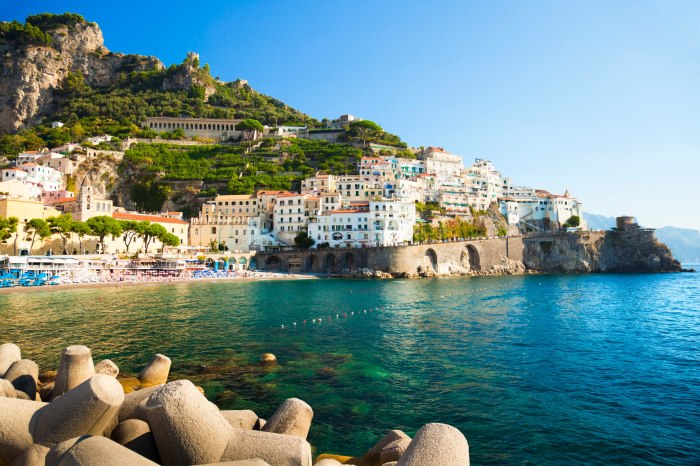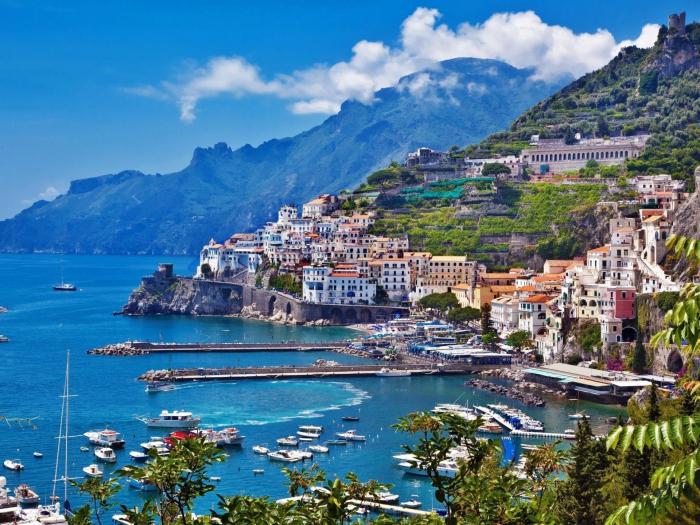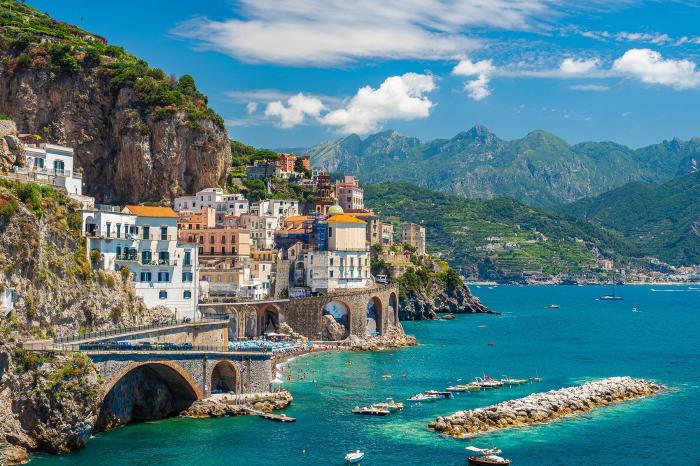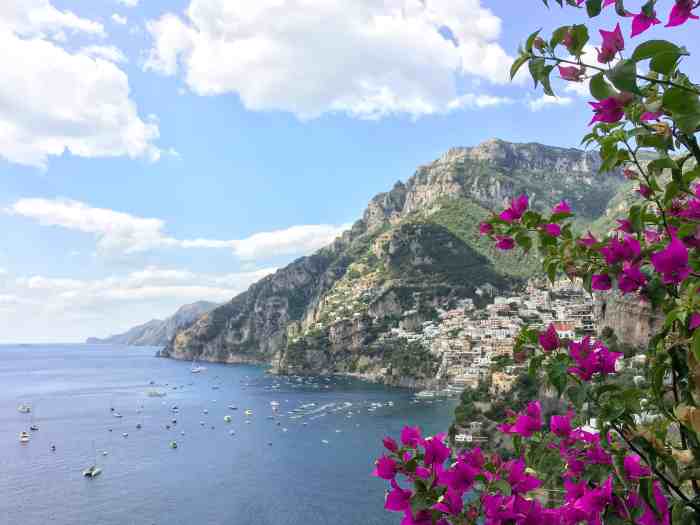Prepare to be mesmerized by the Amalfi Coast, a breathtaking stretch of Italian coastline that effortlessly blends historical charm with natural splendor. This enchanting destination invites you to delve into a world of captivating towns, dramatic cliffs, and crystal-clear waters, all while immersing yourself in a rich cultural heritage that has shaped its unique identity.
From the vibrant streets of Amalfi to the picturesque terraces of Positano, each town along this iconic coast boasts its own allure, beckoning you to explore its hidden gems and soak in the timeless beauty that surrounds it.
Geography and Location

The Amalfi Coast, a breathtaking stretch of coastline in southern Italy, is situated on the western side of the Italian Peninsula, in the Campania region. This enchanting destination is part of the province of Salerno and faces the Tyrrhenian Sea.
The Amalfi Coast is a stunning destination known for its breathtaking scenery and charming towns. To make your trip more sustainable, consider adopting eco-friendly travel tips. Choose eco-friendly accommodations, opt for local transportation, and support businesses that prioritize sustainability.
By following these tips, you can enjoy the beauty of the Amalfi Coast while minimizing your environmental impact.
The Amalfi Coast is renowned for its unique topography, characterized by steep, rugged cliffs that dramatically plunge into the azure waters below. The coastline is dotted with picturesque towns and villages, each perched precariously on the edge of the cliffs, offering breathtaking views of the sea and the surrounding landscape.
Unique Topography
The Amalfi Coast’s topography is the result of millions of years of geological activity. The region is located on the edge of the Apennine Mountains, which have been uplifted and folded over time. The resulting cliffs and valleys create a stunning and dramatic landscape.
The coastline is further shaped by the action of the sea. The waves have eroded the cliffs, creating deep ravines and sea caves. The resulting coastline is a fascinating blend of sheer cliffs, secluded beaches, and hidden coves.
Historical Significance
The Amalfi Coast boasts a rich and captivating history, dating back to the Middle Ages. It played a pivotal role in the establishment of the Maritime Republic of Amalfi, a powerful maritime republic that flourished from the 9th to the 12th centuries.
The Republic of Amalfi, with its capital in the city of Amalfi, emerged as a major maritime power in the Mediterranean Sea. Its strategic location, nestled between the sea and the mountains, allowed it to control trade routes and establish a vast network of trading posts throughout the Mediterranean and beyond. The Republic’s maritime prowess and commercial success led to the accumulation of great wealth and the development of a sophisticated and vibrant culture.
Cultural and Architectural Heritage
The cultural and architectural heritage of the Amalfi Coast is a testament to its historical significance. The region is dotted with numerous churches, monasteries, and other historical structures that reflect the artistic and architectural influences of different periods. The most notable architectural style is the Amalfi Romanesque, characterized by its distinctive use of arches, columns, and decorative elements.
- Amalfi Cathedral: This magnificent 9th-century cathedral is a masterpiece of Amalfi Romanesque architecture, showcasing intricate mosaics, colorful frescoes, and a stunning bell tower.
- Ravello: This hilltop town is home to the Villa Cimbrone, renowned for its beautiful gardens and stunning views of the coastline. The town also boasts the Ravello Cathedral, a fine example of Amalfi Romanesque architecture.
- Positano: This picturesque town is known for its colorful houses cascading down the cliffs, creating a breathtaking visual spectacle. Positano’s Church of Santa Maria Assunta features a distinctive majolica dome.
Natural Beauty and Landscapes

The Amalfi Coast is renowned for its breathtaking natural beauty, a harmonious blend of picturesque towns, dramatic cliffs, and crystal-clear waters. Its stunning landscapes have captivated visitors for centuries, inspiring artists, writers, and poets alike.
The region’s geological history has played a significant role in shaping its scenic allure. The coastline was formed by the collision of the African and Eurasian tectonic plates, resulting in the uplift of the Lattari Mountains. These mountains form a dramatic backdrop to the coast, plunging into the sea to create towering cliffs and secluded coves.
Geological Formations
- Limestone Cliffs: The Amalfi Coast is characterized by towering limestone cliffs that rise sheer from the sea. These cliffs have been sculpted by centuries of erosion, creating intricate formations and hidden grottoes.
- Fjord-like Bays: The coastline is punctuated by fjord-like bays, such as the Bay of Salerno and the Bay of Amalfi. These bays were formed by glaciers during the last ice age, carving out deep inlets and creating sheltered harbors.
- Sea Stacks: Scattered along the coast are sea stacks, isolated rock formations that rise from the sea. These stacks are remnants of ancient cliffs that have been eroded by waves and wind.
Environmental Characteristics
- Mediterranean Climate: The Amalfi Coast enjoys a mild Mediterranean climate with warm, dry summers and mild, wet winters. This climate supports a diverse range of vegetation, including olive groves, vineyards, and citrus trees.
- Marine Biodiversity: The waters of the Amalfi Coast are home to a rich marine ecosystem, including a variety of fish, mollusks, and crustaceans. The coastline is also a nesting ground for several species of seabirds, including the European shag and the peregrine falcon.
- Coastal Erosion: The Amalfi Coast is vulnerable to coastal erosion due to its steep cliffs and the erosive force of waves. To protect the coastline, local authorities have implemented a number of measures, including the construction of seawalls and the restoration of natural habitats.
Cultural Experiences and Tourism

The Amalfi Coast boasts a vibrant and rich culture that captivates visitors from around the globe. Its traditions, cuisine, and local crafts are deeply intertwined with its stunning natural beauty, creating an unforgettable experience.
The region’s cuisine is a culinary masterpiece, showcasing the flavors of the Mediterranean. Fresh seafood, fragrant herbs, and locally produced olive oil are the cornerstones of traditional dishes. From mouthwatering pasta with lemon and anchovies to delectable seafood stews, the Amalfi Coast’s cuisine tantalizes taste buds.
Local Crafts
The Amalfi Coast is renowned for its skilled artisans who have passed down traditional crafts for generations. Ceramic-making is a thriving industry, with colorful and intricate pieces adorning shops and homes. Leatherworking is another local specialty, with craftsmen creating high-quality bags, shoes, and accessories.
Escape to the breathtaking Amalfi Coast, where picturesque cliffs meet turquoise waters. For a change of pace, venture to the Allianz Arena , a modern architectural marvel in Munich. Witness the passion of football fans as Bayern Munich takes to the field, then return to the serene beauty of the Amalfi Coast for a rejuvenating retreat.
Tourism
Tourism plays a vital role in the economy of the Amalfi Coast. The region’s natural beauty, cultural heritage, and accessibility from major cities make it a popular destination. While tourism has brought economic prosperity, it has also presented challenges, such as managing crowds and preserving the fragile ecosystem.
Sustainable tourism practices are being implemented to ensure the long-term viability of the region. Efforts are made to minimize environmental impact, promote responsible travel, and support local communities.
Notable Towns and Villages
Nestled along the breathtaking coastline of the Amalfi Coast, a constellation of charming towns and villages beckon travelers with their unique allure. Each destination boasts a captivating blend of historical significance, architectural wonders, and enchanting natural beauty.
From the vibrant streets of Amalfi to the picturesque cliffs of Positano and the serene heights of Ravello, these settlements offer an unforgettable journey through time and nature.
Amalfi
Amalfi, the heart of the Amalfi Coast, enchants visitors with its rich history as a maritime republic. The town’s Duomo, a magnificent example of Arab-Norman architecture, stands as a testament to its past glory. Its bustling streets, lined with colorful buildings and artisan shops, invite exploration.
Positano
Perched on dramatic cliffs overlooking the Tyrrhenian Sea, Positano is a picturesque haven. Its cascading whitewashed houses, adorned with vibrant bougainvillea, create a breathtaking spectacle. The Spiaggia Grande, a crescent-shaped beach, offers panoramic views and invites relaxation.
Ravello
Nestled high above the coast, Ravello offers a tranquil escape. Its enchanting gardens, Villa Cimbrone and Villa Rufolo, provide panoramic views and a glimpse into its aristocratic past. The town’s serene atmosphere and breathtaking landscapes inspire tranquility and contemplation.
Gastronomy and Cuisine
The Amalfi Coast is renowned for its culinary delights, which showcase the freshest seafood, locally grown produce, and traditional dishes passed down through generations. The region’s cuisine is influenced by its proximity to the sea, as well as the flavors and cooking techniques of neighboring regions like Campania and Calabria.
Fresh Seafood
The Amalfi Coast is a haven for seafood lovers, with an abundance of fresh catches from the Mediterranean Sea. Local fishermen bring in a variety of fish, shellfish, and crustaceans, including sea bass, sea bream, mussels, clams, and lobsters. These are often grilled, baked, or fried in simple preparations that enhance their natural flavors.
Local Produce
The fertile hillsides of the Amalfi Coast produce an array of fresh fruits, vegetables, and herbs. Lemons are particularly famous in the region, and are used in a variety of dishes, from pasta sauces to desserts. Other local specialties include tomatoes, artichokes, olives, and capers. These ingredients are often incorporated into traditional dishes, adding vibrant colors and fresh flavors.
Traditional Dishes
The Amalfi Coast has a rich culinary tradition, with many dishes that have been passed down for centuries. One of the most famous is scialatielli, a type of handmade pasta made with a mixture of wheat flour and semolina. It is often served with a seafood sauce or a hearty ragu. Other popular dishes include insalata Caprese, a simple salad made with fresh tomatoes, mozzarella, and basil, and frittura di paranza, a fried seafood platter featuring a variety of small fish and shellfish.
Art and Architecture

The Amalfi Coast boasts a rich artistic and architectural heritage, reflecting the region’s diverse cultural influences.
The churches and monasteries of the coast are architectural marvels, showcasing a blend of Romanesque, Byzantine, and Gothic styles. The Amalfi Cathedral, built in the 9th century, is a prime example, featuring intricate mosaics and a striking bell tower. The Monastery of San Lorenzo, perched high on a clifftop, offers breathtaking views and houses a collection of medieval frescoes.
Villas along the coast are also architectural masterpieces, combining elements of classical Roman and Renaissance design. The Villa Rufolo in Ravello, built in the 13th century, is renowned for its terraced gardens and panoramic views. The Villa Cimbrone, also in Ravello, features a stunning infinity pool overlooking the sea.
Unique Architectural Styles, Amalfi coast
The Amalfi Coast is known for its unique architectural styles, characterized by whitewashed walls, arched doorways, and colorful ceramic tiles. The use of local stone, such as limestone and tuff, gives the buildings a warm and inviting appearance.
Decorative Elements
The region’s architecture is adorned with intricate decorative elements, including majolica tiles, wrought-iron balconies, and painted ceilings. The colorful tiles, often depicting scenes from mythology or daily life, add a vibrant touch to the buildings. The wrought-iron balconies, with their delicate scrollwork, provide an elegant contrast to the whitewashed walls.
Outdoor Activities and Recreation

The Amalfi Coast offers a plethora of outdoor activities that cater to nature enthusiasts and adventure seekers alike. From leisurely strolls along scenic trails to exhilarating boat excursions and refreshing swims in crystal-clear waters, there’s something for every outdoor enthusiast.
Hiking enthusiasts will find themselves in paradise, with an extensive network of trails traversing the rugged coastline and verdant hillsides. The Sentiero degli Dei (Path of the Gods) is a legendary hike that rewards hikers with breathtaking panoramic views of the coastline and the islands of Capri and Ischia.
Boating and Sailing
The Amalfi Coast is a boater’s paradise, with its calm turquoise waters and sheltered coves. Visitors can embark on boat tours that explore hidden grottoes, secluded beaches, and picturesque towns. Sailing enthusiasts can charter a yacht and set sail for a day of exploration and relaxation, enjoying the stunning coastal scenery from a unique perspective.
The Amalfi Coast, with its dramatic cliffs and picturesque villages, is a must-see for any traveler. If you’re looking for a similar experience closer to home, check out the Atlanta Beltline. This 22-mile loop trail around Atlanta offers stunning views of the city skyline and surrounding neighborhoods.
Like the Amalfi Coast, the Atlanta Beltline is a great place to walk, bike, or simply relax and enjoy the scenery.
Swimming and Snorkeling
The crystal-clear waters of the Amalfi Coast are perfect for swimming and snorkeling. Visitors can dive into the refreshing waters from secluded beaches or hop on a boat to explore the vibrant underwater world. The coastline is home to a variety of marine life, including colorful fish, sea turtles, and playful dolphins.
Final Review
As you bid farewell to the Amalfi Coast, the memories you create here will linger long after your departure. This enchanting region has a way of weaving its magic into your soul, leaving you yearning to return to its shores time and time again.
Answers to Common Questions: Amalfi Coast
What is the best time to visit the Amalfi Coast?
Spring and fall offer the most pleasant weather for exploring the Amalfi Coast, with warm temperatures and fewer crowds.
What are some of the must-see towns along the Amalfi Coast?
Amalfi, Positano, Ravello, and Sorrento are among the most popular and picturesque towns along the coast.
What are some of the activities that can be enjoyed on the Amalfi Coast?
Hiking, swimming, boating, and exploring the charming towns and villages are just a few of the many activities that the Amalfi Coast has to offer.